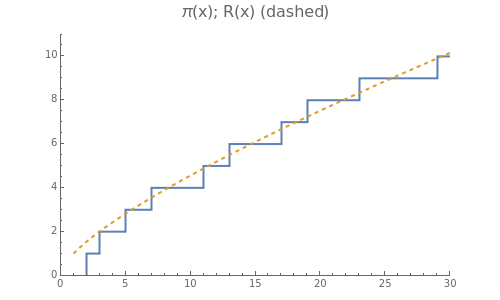How the Zeros of the Zeta Function Predict the Distribution of Primes
How the Zeros of the Zeta Function Predict the Distribution of Primes
In number theory, is the number of primes less than or equal to . Primes occur seemingly at random, so the graph of is quite irregular. This Demonstration shows how to use the zeros (roots) of the Riemann zeta function to get a smooth function that closely tracks the jumps and irregularities of . This illustrates the deep connection between the zeros of the zeta function and the distribution of primes.
π(x)
x
π(x)
ζ(s)
π(x)
Details
Details
Snapshot 1: the graphs of and with no correction term
π(x)
R(x)
Snapshot 2: the graphs of and with correction term that uses the first 20 pairs of zeros of the zeta function
π(x)
R(x)
Snapshot 3: a closeup showing that with correction term correctly predicts the primes 103, 107, 109, 113, and 127, and the gap between 113 and 127; notice that, with no correction term, by itself misses these details
R(x)
R(x)
The function (Mathematica's built-in function PrimePi[x]) is a step function that jumps by 1 whenever is prime. Riemann's prime-counting function (Mathematica's built-in function RiemannR[x]) is defined as
π(x)
x
R(x)
R(x)=li()
∞
∑
n=1
μ(n)
n
1/n
x
where is the Möbius mu function μ (MoebiusMu[n] in Mathematica) and
μ(n)
li(x)=dt
x
∫
0
1
log(t)
is the logarithmic integral (Mathematica's built-in function LogIntegral[x]).
Overall, is a good approximation to . However, does not track the details, that is, the jumps) of . Furthermore, when a gap occurs in the primes (as, for example, between 23 and 29), keeps increasing even though remains constant between primes.
R(x)
π(x)
R(x)
π(x)
R(x)
π(x)
However, if we add to a correction term that uses the first few zeros (roots) of the Riemann zeta function, something very surprising happens: we get a new function that very closely matches the jumps and irregularities of ! When is prime, this new function increases by about 1 near , so, in effect, it "knows" where the primes are. And when a gap occurs, this new function tends to level out, again emulating the behavior of .
R(x)
π(x)
x
x
π(x)
It's almost as if the zeros of the zeta function determine which numbers are prime!
The first three complex zeros of the zeta function are approximately , , and . The zeros occur in conjugate pairs, so if is a zero, then so is . The famous Riemann hypothesis is the claim that these complex zeros all have real part 1/2. All of the first complex zeros do, indeed, have real part 1/2 (see[4]).
1/2+14.135i
1/2+21.022i
1/2+25.011i
a+bi
a-bi
13
10
This Demonstration uses an exact formula for a function that is equal to except when is prime. We define our new prime counting function, usually denoted by (x), as follows. First, if is a prime number, say, , then jumps from to . For this , we will define (x) to be halfway between these two values: that is, (p)=π(p)-1/2. Second, for all other values of , (x)=π(x). With this definition in mind, (x) has the following exact formula:
π(x)
x
π
0
x
p
π(x)
π(p)-1
π(p)
x
π
0
π
0
x
π
0
π
0
(1) (x)=R(x)+f(),
π
0
∞
∑
n=1
μ(n)
n
1/n
x
where is Riemann's prime counting function defined above, and
R(x)
(2) ,
f(x)=-2ReEi(log(x))+dt-log(2)
∞
∑
k=1
ρ
k
∞
∫
x
1
(-t)log(t)
3
t
where is the complex zero of the zeta function. In this formula, (Mathematica's built-in function ExpIntegralEi[z]) is the generalization of the logarithmic integral to complex numbers. These equations come from references[1],[2], and[3].
ρ
k
th
k
Ei(z)
For a given , and with the value of that you choose with the slider control, here is how this Demonstration computes the correction term that involves zeta zeros:
x
N
First, let be the smallest integer such that <2. We need to add only the first terms (that is, ) in the sum in equation (1). For each of these values of , we use equation (2) to compute the value of . However, we will add only the first terms (that is, ) in the sum in equation (2). Because the purpose of this Demonstration is to show how the jumps in the step function can be closely approximated by adding to a correction term that involves zeta zeros, we ignore the integral and the in equation (2); this speeds up the computation and will not noticeably affect the graphs, especially for more than about 5.
M
1/M
x
M-1
n=1,2,…,M
n
f()
1/n
x
N
k=1,2,…,N
π(x)
R(x)
log(2)
x
The more zeros we use, the closer we can approximate . For larger , the correction term must include more zeros in order to accurately approximate .
π(x)
x
π(x)
References:
[1] H. Riesel, Prime Numbers and Computer Methods for Factorization, 2nd ed., Boston: Birkhauser, 1994 pp. 44–55.
[1] H. Riesel, Prime Numbers and Computer Methods for Factorization, 2nd ed., Boston: Birkhauser, 1994 pp. 44–55.
[2] H. Riesel and G Gohl, "Calculations Related to Riemann's Prime Number Formula," Mathematics of Computation, 24(112), 1970 pp. 969–983.
[3] S. Wagon, Mathematica in Action, 2nd ed., New York: Springer, 1999 pp. 540–554.
External Links
External Links
Permanent Citation
Permanent Citation
Robert Baillie
"How the Zeros of the Zeta Function Predict the Distribution of Primes"
http://demonstrations.wolfram.com/HowTheZerosOfTheZetaFunctionPredictTheDistributionOfPrimes/
Wolfram Demonstrations Project
Published: March 7, 2011
